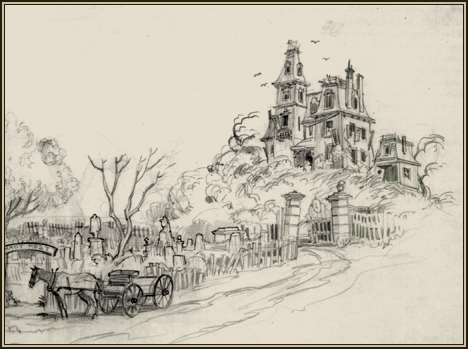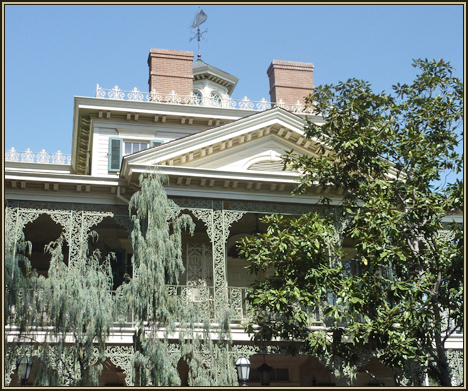
The Old Mansion
Walt Disney was planning his very own amusement park and, true to his background in the motion picture industry, had asked a number of artists to provide visual concepts. His Disneyland wouldn’t just be a collection of iron rides and arcades, like the parks and fairs known at the time, but a thoroughly cinematic experience. Visitors would feel as if they had stepped through the screen and got to stroll into nostalgic or exotic locations familiar from the movies of the time.
It was only fitting that many of the artists who began drawing up concepts for this ambitious project were themselves animators or Hollywood production designers. One of them, probably most famous for designing the iconic Nautilus submarine for Disney’s 20,000 Leagues Under the Sea, was artist Harper Goff. In fact, it was his sketch of a residential street that was planned but ultimately abandoned for Disneyland’s Main Street which started the history of Phantom Manor.

Goff’s ramshackle Victorian mansion on a hill would be the first of many different concepts for a haunted house ride at Walt Disney’s new theme park. Neither its location nor its building style, nor even the dilapidated exterior, would survive the creative process during the following years. Walt Disney himself, no doubt wishing to distinguish his park from the run-down amusement parks of the era, wanted every building at Disneyland to be in pristine condition.

Due to various challenges, changes in scope, and other projects taking up time, development of the Haunted Mansion would continue for almost two decades after this initial illustration. This gave illusionist Yale Gracey time to invent and refine a number of special effects for the project together with artist Rolly Crump. Ken Anderson found the appropriate exterior for its new Southern setting in Disneyland’s New Orleans Square. Audio-Animatronics technology was invented and incorporated into the show. The Omnimover ride system was developed and deemed best suited for the Haunted Mansion. And a winning team of creative artists was forming...
Much as they had successfully done for Pirates of the Caribbean, artist Claude Coats would develop the ride’s atmosphere and ghostly environments, animator Marc Davis would come up with characters and gags, and X. Atencio was charged with making it all fit together and providing the appropriate dialogue and lyrics. Under the guidance of Walt, this group had found the perfect balance making Pirates of the Caribbean a masterpiece of theme park entertainment.
But Walt Disney would not live to see the finished flagship attraction in 1967, and without his authority and influence a creative conflict over the direction of the Haunted Mansion ensued.
Marc Davis, with his light-hearted character vignettes, wanted the Mansion to be a humorous ghost house parody, while Claude Coats was taking his artwork into a darker angle; his idea of the perfect haunted house was mysterious and genuinely scary.

It fell to X. Atencio to come up with a compromise and combine the best of both worlds.
The ride as it was ultimately opened in 1969 was almost split in half as a result, with a darker first half and a lighter second half. The element that connected these show scenes was Atencio’s ghost host narration, provided by actor Paul Frees, which spanned the ride by means of speakers in the ride vehicles.
During production of the first Haunted Mansion, it was decided that the soon-to-open Walt Disney World in Florida would receive its own slightly-adapted version, and so two copies were created right away of every important show element. The second Mansion’s exterior would be changed to reflect its setting in Liberty Square, a few scenes were reduced while others were added, but the basic ideas remained.
A decade later, the Japanese wanted a park that felt as much as possible like its American counterparts. Tokyo Disneyland, the first Disney park outside the United States, would get a copy of its Florida counterpart, only slightly enhanced to fit into that park’s Fantasyland.

When it came to bringing Disneyland to Europe, however, things were turning out to be very different...

|

